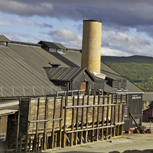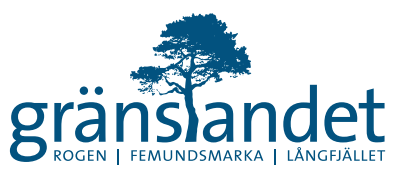 Mountain holding – a meeting place for man and beast.
Mountain holding – a meeting place for man and beast.
Farmers and herdswomen
Some farms, especially around Femundsmarka, date back to the 17th century when Røros Copper Works was founded. But most of Gränslandet’s farms on the Swedish side are from the 19th century.
Had it not been for the copper works, there would not have been so many farms in the area. Working in the mines and blast furnaces required a lot of labour, as did the transport of ore, copper, coal and wood. But the work was seasonal and was therefore combined with farming and mountain holdings. Many farms became important trading places and also provided accommodation for people who worked for the copper works and forestry companies.
In the 19th century, the population in Scandinavia increased. Many people emigrated to America, while others became settlers in remote mountain areas and outlands. Some settlements in Gränslandet were set up in reindeer enclosures, already open grassland where Sami had previously lived.
Among “butauser” and “kjesmus”
Mountain farms were based on livestock, which required large hay meadows and pastures. To access more land, the cattle were driven from the farm to the mountain holding where they remained for a few hot months in the summer.
It was women who carried out the work on mountain holdings. In Jämtland they were called butause. They looked after the cattle and made dairy products to last over the winter. From the milk they made cheese and butter. They also made kjesmus, cottage cheese, soft whey cheese and other traditional dairy products.
Winter holdings in Femundsmarka
Normally, the mountain holdings were abandoned over winter, but in Femundsmarka they were sometimes kept open until Christmas. People and cattle returned home in September so that the animals could graze the mown meadows. When the pastures on the farm were exhausted, they went back to the mountain holding where the animals could eat hay that had been harvested on the summer pastures. They stayed until Christmas, when it was time to go back to the farm. This was a way of making the most of hay and grazing.
Cattle and cattle sheds
In Gränslandet you encounter native goat and cattle breeds such as Røros cattle and Swedish mountain cattle. Animals of these breeds are well adapted to the rugged terrain, sparse grazing and long winters. In the past, native breeds were much more common, but now there are only a few small herds left.
Some mountain holdings are still actively worked! Others have been abandoned, but their traces are still here. Ageing buildings for people, cattle and supplies stand as reminders of a time when mountain farming played a large role in the region.
 Many who worked at Røros Copper Works farmed on the side!
Many who worked at Røros Copper Works farmed on the side!
 Herdswoman at Lofjätåsen, 2010.
Herdswoman at Lofjätåsen, 2010.
 Goat at Lofjätåsen.
Goat at Lofjätåsen.
 One of many buildings on the holding – a storehouse for cooling milk.
One of many buildings on the holding – a storehouse for cooling milk.
Photos: Naturcentrum AB.
The right of public access does not apply...
... on farms and mountain holdings! Mountain holdings are not public open-air museums. You are visiting someone’s home.
A mountain summer pasture...
... is where cattle can graze freely or herded during the summer months. Read more »





